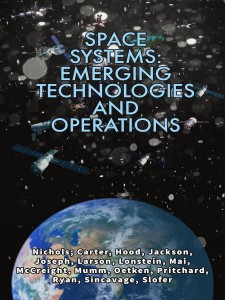SPACE SYSTEMS: EMERGING TECHNOLOGIES AND OPERATIONS
By Dr. Hans C. Mumm
https://www.amazon.com/gp/product/B0BHNLQSNQ/ref=dbs_a_def_rwt_hsch_vamf_tkin_p1_i4
https://newprairiepress.org/ebooks/47/
https://kstatelibraries.pressbooks.pub/spacesystems/
SPACE SYSTEMS: EMERGING TECHNOLOGIES AND OPERATIONS
is our seventh textbook in a series covering the world of UASs / CUAS/ UUVs. Other textbooks in our series are Drone Delivery of CBNRECy – DEW Weapons: Emerging Threats of Mini-Weapons of Mass Destruction and Disruption (WMDD); Disruptive Technologies with applications in Airline, Marine, Defense Industries; Unmanned Vehicle Systems & Operations On Air, Sea, Land; Counter Unmanned Aircraft Systems Technologies and Operations; Unmanned Aircraft Systems in the Cyber Domain: Protecting USA’s Advanced Air Assets, 2nd edition; and Unmanned Aircraft Systems (UAS) in the Cyber Domain Protecting USA’s Advanced Air Assets, 1st edition. Our previous six titles have received considerable global recognition in the field. (Nichols & Carter, 2022) (Nichols, et al., 2021) (Nichols R. K., et al., 2020) (Nichols R., et al., 2020) (Nichols R. , et al., 2019) (Nichols R. K., 2018) [1]
Our seventh title takes on a new purview of Space. Let’s think of space as divided into four regions. Planets, solar systems, and the great dark void fall into the purview of astronomers and astrophysics. The earth, from a measurement standpoint, is the baseline of space. It is the purview of geographers, engineers, scientists, politicians, and romantics. Flying high above the earth are Satellites. Their purview is governed by military and commercial organizations. The lowest altitude at which air resistance is low enough to permit a single complete, unpowered orbit is approximately 80 miles (125 km) above the earth’s surface. Normal LEO satellite launches range between 99 miles (160 km) to 155 miles (250 km). Satellites in higher orbits experience less drag and can remain in space longer in service. Geosynchronous orbit is around 22,000 miles (35,000 km). However, orbits can be even higher. The Russians claim they placed a radio astronomy satellite in a long elliptical orbit that carries it nearly as far as the moon. (Hardwick, 2022) UASs (Drones) have a maximum altitude of about 33,000 ft (10 km) because rotating rotors become physically limiting. (Nichols R. , et al., 2019) Recreational drones fly at or below 400 ft in controlled airspace (Class B, C, D, E) and are permitted with prior authorization by using a LAANC or DroneZone. Recreational drones are permitted to fly at or below 400 ft in Class G (uncontrolled) airspace. (FAA, 2022) However, between 400 ft and 33,000 ft is in the purview of DREAMERS.
In the DREAMERS region, space has its most interesting technological emergence. We see emerging technologies and operations that may have profound effects on humanity. This is the mission our book addresses. We look at the Dreamer region from three perspectives: a military view where intelligence, jamming, spoofing, advanced materials, and hypersonics are in play. An exploration of the challenges in the Dreamer region follows. These include space-based platform vulnerabilities, trash, disaster recovery management, AI, manufacturing, and extended reality. Lastly, we dramatically shift to the humanitarian use of space technologies. This includes precision agriculture wildlife tracking, fire risk zone identification, and improving the global food supply and cattle management.
State-of-the-Art research by a team of fifteen SMEs is incorporated into our book. We trust you will enjoy reading it as much as we have in its writing. There is hope for the future.
https://www.amazon.com/gp/product/B0BHNLQSNQ/ref=dbs_a_def_rwt_hsch_vamf_tkin_p1_i4
https://newprairiepress.org/ebooks/47/
https://kstatelibraries.pressbooks.pub/spacesystems/
